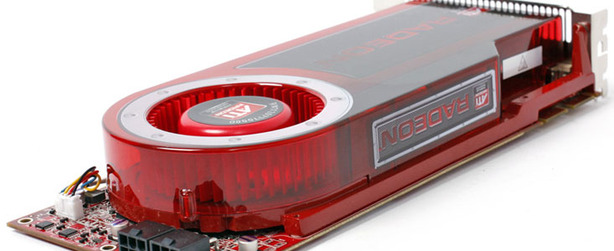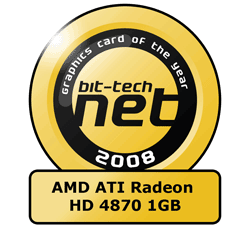
Best Graphics Card: AMD ATI Radeon HD 4870 1GB
Notable Mentions: Nvidia GeForce GTX 260-216, AMD ATI Radeon HD 48502008 has been an interesting year in the graphics industry in many ways, with the biggest news being AMD’s return to form with the ATI Radeon HD 4000 series. Without the Radeon HD 4800 series in particular, 2008 could have been a year of stagnation in the graphics card market – the first half of the year firmly belonged to Nvidia, but not in the emphatic fashion that we would have expected.
Nvidia rested on its laurels for too long in our opinion following the massive success that was the GeForce 8800 series – we ended up with a number of disappointing product releases. The GeForce 9800 GTX was nothing more than a slightly boosted GeForce 8800 GTS 512 and was no match for the original GeForce 8800 GTX and Ultra when anti-aliasing was enabled, while the GeForce 9800 GX2 had its own problems.
These ranged from lack of support for multiple monitors without switching from multi-GPU mode (SLI, in other words) to multi-monitor mode – now fixed to some extent in the release 180 series drivers – and overheating on some SLI certified motherboards with the NF200 bridge chip directly underneath the cooler. Despite these problems, it’s still one of the fastest graphics cards available when the SLI profiles in Nvidia’s drivers manage to work their magic.

AMD started the year quite well with the ATI Radeon HD 3870 X2 and signalled its intentions for the coming year. Its focus would move away from building a giant GPU to conquer all at the bleeding edge and it would instead reach the ultra high end with a pair of GPUs in CrossFire. It didn’t pay off with the Radeon HD 3870 X2, as the RV670 GPU just wasn’t powerful enough to deliver better performance than a single GeForce 8800 GTX or Ultra on a consistent basis – the benefits didn’t outweigh the drawbacks in this case.
The first half of the year, then, was pretty boring from our perspective and things didn’t really start to kick off until the middle of June when Nvidia launched the GeForce GTX 200 series GPUs. This was then closely followed by the Radeon HD 4800 series – the Radeon HD 4850 512MB and 4870 512MB cards were the two available on launch – a week later.
While there was nothing really wrong with the GeForce GTX 200 series cards from an architectural perspective and in isolation, the moment you put them next to the Radeon HD 4800 series, they looked out of place and massively overpriced. The Radeon HD 4870 512MB, for example, delivered about 80 percent of the GeForce GTX 280’s performance for about half of its price (at launch). On the other hand, the Radeon HD 4850 512MB led to Nvidia cutting the price of the GeForce 9800 GTX in half overnight and also forced it to paper launch the GeForce 9800 GTX+ – an overclocked 9800 GTX based on a 55nm G92 chip.

It took Nvidia a while to recover from this as it had all come at the same time as the company warned that it was experiencing higher than expected failure rates on a number of its products in notebooks. Things then got worse when AMD announced the ATI Radeon HD 4870 X2, as it raised the bar so high that Nvidia wouldn’t be able to re-take the performance crown (in a single PCIe slot) until the GeForce GTX 295’s

But Nvidia still ploughed on and in September it announced the GeForce GTX 260-216 – an uprated version of the original GeForce GTX 260, which had an extra shader processing cluster enabled – which was designed to sit up against the Radeon HD 4870 1GB. Originally, the GeForce GTX 260-216 didn’t fair too well against the latest addition to the Radeon HD 4800 series, but the water wasn’t so clear after Nvidia had released the 180 series drivers.
Despite this though, the Radeon HD 4870 1GB was our card of the year because – for the first time in recent memory – the additional memory did unlock more performance and, as some of the latest titles were released, that performance gap increased beyond the difference in price. What’s more, the Radeon HD 4870 1GB makes the GeForce GTX 280 look like poor value for money because it’s not that much slower – and is in fact faster in some scenarios – while costing quite a bit less.
We could harp on about CUDA and PhysX, but they didn’t really make a telling difference in 2008 – that’s not to say they won’t change the landscape in 2009, but we’re not writing about the future today.

MSI MPG Velox 100R Chassis Review
October 14 2021 | 15:04








Want to comment? Please log in.